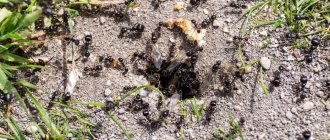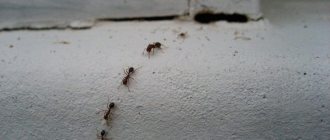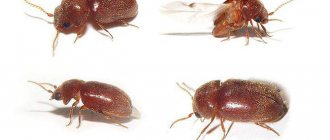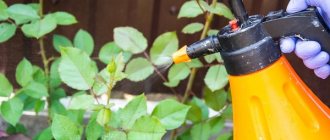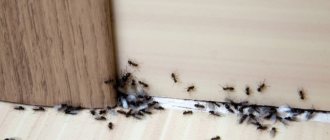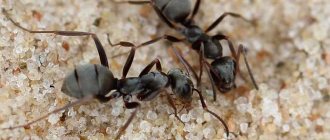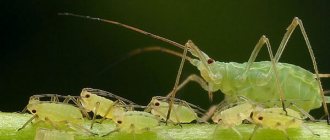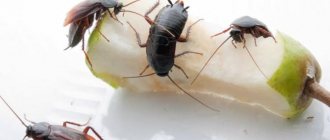There are many insects living in a garden or summer cottage. Some of them are beneficial, and some are harmful. Ants do both. They make the soil in the beds loose, so that it is better saturated with oxygen, and they also improve the composition of the soil, introducing phosphorus and potassium into it in a form suitable for plants. They also destroy a number of harmful insects. But at the same time, the ants themselves are more likely to be pests in the garden. Gardeners and summer residents fight ants every summer. It is impossible to get rid of ants in your garden beds once and for all, but you can drive them away for a while to get a rich harvest.
What harm do ants do in garden beds?
There are several types of ants in the garden. Sometimes these are red forest ants that wander in by chance in search of food if the area is near a forest. They build an anthill in the forest, and not next to a person. But more often these are black garden ants, which build their home in the garden. They feed on sweet fruits and berries, and also breed aphids, which devour juicy fresh leaves, shoots, and fruits of plants grown by humans.
It is necessary to fight against ants in the garden and in the beds, otherwise you may lose part or all of the harvest.
What harm do garden ants cause?
- grow, distribute, protect and protect aphids - one of the main pests of trees and shrubs: ants feed on the honeydew that aphids secrete, therefore they are interested in increasing the number of these pests; these two types of insects live in symbiosis, so you need to fight both garden ants and aphids at the same time;
- ants eat berries, they are very fond of, for example, strawberries, and also eat flowers and buds, preventing fruits from forming;
- eat and spoil shoots and root vegetables with a high sugar content;
- can bite a person working with the soil, and their bites are unpleasant;
- if an anthill is built on a garden bed, the soil around it becomes less fertile;
- digging passages and holes for themselves, ants gnaw the roots of plants;
- with a large number of ants in the beds, the soil becomes too acidic and becomes unsuitable for growing vegetables.
Before getting rid of garden ants, it is important to understand that these insects are both harmful and beneficial. If the colony is small, and individual ants are just coming to the beds, then they are included in the general ecosystem and are rather useful. But if they have chosen your garden as a permanent place of residence and built their anthill here, then it makes sense to start fighting them.
Types of ants
House ants and forest ants are two different types of insects that differ in size, feeding methods and habitat. The red species living in the forest are hard workers who build large anthills and destroy forest pests; they have a size of 4-9 mm. Domestic aliens are very small, barely growing to 3 mm, which can settle anywhere in the house, but have nothing to do with their forest brothers.
On a note!
These 2 types of ants also differ in character: forest dwellers, defending their nest, may well bite a person or an animal that disturbs their peace, but domestic ones do not bite at all.
Black ants or garden ants are pests that cause a lot of trouble for gardeners. They settle on some plant along with aphids, which they use for their food. After some time, the plant affected by aphids dies. Therefore, all gardeners and gardeners will have to protect their plantings from such pests so as not to lose their harvest. Knowing which plants garden ants don’t like, this is within everyone’s power.
Types of ants
How to get rid of ants in the garden
The beds are designed for growing a wide variety of plants. They are usually located next to each other, so ants can move between them without any problems. Even if the crop itself is not very attractive to them, they can ruin it by laying ant trails along it.
If there are ants in the garden, you need to remove them carefully, trying not to harm the plantings. You cannot water or fill the beds with chemicals. They are toxic and can destroy plants or make them dangerous to humans. To get rid of ants in garden beds, you need to use only safe products.
About breeding methods
Cases when a flower bed becomes infested with insects are not uncommon. The most common treatment method for getting rid of ants on flowers is spraying with potent drugs, for example, Anteater.
You can destroy insects without damaging the bud or other parts of the plant using an infusion of aromatic citrus peels or a celandine solution, which is prepared by infusing a bunch of flowers for two days.
For house flowers growing in pots located outside, for example, on a veranda, you can fumigate them with tobacco smoke by placing them in a plastic bag and leaving them until the morning. This method is aimed at destroying aphids and repelling ants.
The safest method of removing ants from a garden plot is to install a sweet bait. To do this, the remains of old jam are diluted with water (homemade sugar syrup is also suitable), which must be spread throughout the garden plot. Thus, instead of breeding aphids as food, the ants will consume sugar syrup.
Ants can also be exterminated using a solution based on ammonia in the amount of 10 milliliters per 1 liter of boiling water, which must be poured into the anthill.
A solution based on ammonia for ants
Treating the area with boric acid is an effective, highly effective and harmless measure for both flowers and non-pest insects. A mixture of powder and sugar, mixed in equal proportions, can be used to fill the tree trunk, anthill, flowerbed or ridge. Thus, after some time the insects will leave the garden plot.
Moving an anthill
Methods for getting rid of ants can be very controversial and sometimes very complicated. For example, if you find an anthill on your property, you can put it in a plastic bag, removing the entire above-ground part and the underground part - to the depth of a spade bayonet or even deeper. In the bag, the anthill is transferred to the forest away from human habitation and dumped there in a suitable place. The insects themselves will restore it. This is a fairly humane method, but labor-intensive and dangerous - the anthill can be large and heavy, and the ants bite very painfully.
The second way is, on the contrary, to bring an anthill with red ants from the forest to the site and leave it next to the home of the black ants. Two types of insects are at war. The forest ones will destroy the blacks, and they themselves will return to the forest. But the method, of course, is dubious, long and labor-intensive.
Why do ants live in flowers?
Ants appear in indoor flowers for the following reasons:
- irregular cleaning: a full trash can, leftover food on the table and floor - these are the things that attract the attention of pests;
- ants or their eggs can be brought into the house on clothes or shoes from the street;
- due to the fact that these pests are heat-loving insects, with the arrival of cold weather they rush into human housing; the ideal conditions for their stay are in the absence of hygiene;
- insects may come from a neighboring apartment, the owners of which have decided to get rid of pests.
Ants in a flower pot Once in an apartment, ants will definitely take a liking to a flower pot and settle in it. After all, it is in it that favorable conditions are created for pests to live.
How to scare ants away from garden beds
Ants are very sensitive to odors. They are attracted to sweet smells, but they cannot stand aromatic herbs, for example, oregano, parsley, dill, mint, mustard, tobacco, valerian. These plants can be planted in beds - between rows of crops or along the perimeter. They will protect the plantings from ants. Also, insects do not like the smell of tomato tops, garlic, and celandine. Marigolds are also unpleasant for them, so you can repel ants beautifully by planting these flowers between the beds.
In addition to plants, these insects do not like the smell of coal and ash. These substances, in turn, act as fertilizer, so you can scatter ash or burnt coals over the beds. This will repel insects and enrich the soil.
Starch repels garden ants. They avoid it and never eat it. Therefore, you can spread potato peelings between rows of plants or around the beds. Of course, it doesn't look very nice, but it can protect against ant invasion. You can also water the beds with a not very concentrated solution of mustard powder or garlic infusion (a few crushed cloves of garlic per liter of water, leave for a day). This is safe for garden crops, but unpleasant for ants.
The smell of kerosene is very unpleasant for pests. Of course, you shouldn’t water the beds with it, but you can treat the outside of the wooden formwork, if any, as well as the wooden bridges between the beds. They do not use pure kerosene, but diluted in water: 10 tablespoons per 10 liters of water. Instead of pouring, you can use rags soaked in kerosene: it can be placed between the rows of plants. Kerosene can be replaced with other strong-smelling substances: turpentine, vinegar.
Another odorous remedy is ammonia. In small concentrations it is safe for plants, but unpleasant for insects. You can add it to water for irrigation in a ratio of 1:100.
All aromatic methods of fighting ants in garden beds work much worse than in a house or greenhouse, because odors dissipate very quickly in the open air.
How to remove ants from flower pots
How to remove ants from flower pots
There is a list of removal methods if ants appear on flowers and how to fight them:
- The widely used well-known folk method of flooding is carried out by placing a flower pot in a large, deep container, which must be filled with water. If your household equipment does not have a container of a suitable size, the pot is filled to the top with water. After a few minutes, when faced with flooding conditions, the pests will almost stop fussing;
- Work on replacing the soil must be carried out correctly: the pot is turned over and the flower is carefully removed from it. Next, the entire root system is thoroughly cleaned and washed to remove eggs laid by ants;
- The method of applying repellents is to treat the pot and trunk with garlic or vegetable oil.
- The list of herbs that repel ants includes:
- sagebrush;
- mint;
- lavender;
- anise;
- parsley;
- tomato tops;
- basil;
- cinnamon;
- carnation;
- black pepper;
- red pepper.
Herbs for ants
Insects cannot tolerate the smell of the above herbs, which forces them to look for a new habitat.
Helpful advice. If it is impossible to replace the contaminated soil, it must be calcined by placing it in a preheated oven for 20 minutes. The soil can be used for its intended purpose after cooling.
- You can also catch ants by covering a flower pot with tape so that the sticky side faces outward;
- A soap solution for killing ants is prepared from 1 teaspoon of liquid soap dissolved in 0.5 liters of water. The resulting liquid is poured into a spray bottle and used to treat the flower planting by spraying. In addition, it is recommended to pour a little solution into the soil;
- You can exterminate ants by placing a mixture of oatmeal and honey near the container with the flower. Honey is a strong-smelling component that attracts ants, oatmeal is a poisonous substance for these insects, and if they eat it, they will immediately die;
- When ant pockets appear in a flower pot, you can sprinkle the soil with millet. When eating cereal, the ants will die, since due to the swelling of the millet inside the insect, its body is deformed;
Lures and traps
If there are few ants, you can destroy them by preparing traps and bait. As mentioned above, these insects love sweets. In places where ants accumulate, you can place sticky traps from which these pests will not be able to escape. Traps can be made from jam and honey, which need to be placed in bottles or jars. The ants will get inside, but will not be able to get back out. Also, sticky tape can act as a trap, which will trap aphids and ants if you wrap it around the trunks of bushes and trees. Another remedy is vegetable oil. If an ant gets into it, it will not be able to cleanse itself. Vegetable oil can be used to water paths or beds between plantings, but this method may not be the most pleasant for gardeners.
How to properly process peonies
The problem with the presence of ants on peonies is familiar to everyone, so you can use simple folk remedies to eliminate the main colony:
- Mix 5 grams of boric acid with 50 ml of honey, add 50 ml of water. Spread the product in areas frequented by ants.
- You can use plants with a pronounced aroma; lemon peels, mint, tansy, parsley, and fir cones are suitable. They need to be placed around the peonies or planted nearby, and infusions should be prepared for spraying. This will repel the ants.
- You can rub the trunks with garlic to repel them or make an infusion from the head with the addition of soap.
- To prepare the trap, you need to make a circle of cardboard about 15 cm, make a hole inside for the peony stem with a straight cut. Apply Vaseline or Vishnevsky ointment to one side. This will not only repel the ants, but will also allow you to catch them. A few days and they will avoid the bushes.
Coffee also helps against ants. To do this, you need to put the thicket on the ant trails or make a barrier around the peonies. This allows you to protect plants and kill insects.
Destruction of anthills using folk remedies
There are control methods that are undesirable to use in or near garden beds. They will harm not only insects, but also plantings, but if there is no other option to remove ants, then you have to use them. Garden ants do not build an anthill in the form known to everyone, but an underground nest. The entrance to this nest looks like a hole in the ground.
If it is located in a garden bed, you will have to destroy the nest. How can I do that:
- prepare a solution from 100 g of vegetable oil, a liter of boiling water, 5 tablespoons of granulated sugar and 30 g of boric acid, mix thoroughly and pour into the nest, covering the entrance with polyethylene; for greater effect, you can add 200 ml of vinegar to the solution;
- add 2 tablespoons of ammonia to five liters of water and also pour the solution into the nest;
- Mix vegetable oil with boiling water in equal proportions, add ground black pepper, camphor or bay leaf and also pour into the nest.
All these methods are safe for garden beds, but harmful to insects. You may have to repeat filling the anthill several times every 2 to 3 days. You can fill the anthill with quicklime and fill it with water, but in the case of an underground nest, this remedy may not destroy it entirely, but only from above. In addition, lime damages the roots of plants, so you need to use it (as well as pouring boiling water) very carefully near cultivated plants.
Prevention of ants
You can prevent the occurrence of anthills on your garden plot by carrying out gardening activities, including:
- timely digging of the earth;
- if you remove old tree bark;
- placing plant residues in a compost heap during harvesting;
- refusal to plant linden and viburnum in the garden;
- sowing mint, garlic, onions and calendula around the perimeter of the site;
- ridding the land of weeds.
Mint on the site as prevention against ants
At home, you can prevent ants from appearing in the following ways:
- remove food from the table;
- do not leave dirty dishes;
- collect crumbs;
- get rid of stains;
- store garbage in a sealed bag;
- clean the house regularly.
In garden plots, in most cases, ants are not completely exterminated, only the necessary plantings are treated. The only exception is the situation when ants fall into the well. But if they enter domestic living spaces, they can harm both the property and the health of the owners of the house or apartment. In this case, fighting them is mandatory.
Why is it difficult to get rid of garden ants?
Black ants live in the garden in huge colonies, including several thousand adult individuals. Their nest can go a couple of meters into the ground; inside it has a complex layout with a large number of passages, holes, and storage rooms. Deep inside is the queen ant. She is busy reproducing the population. She constantly lays eggs and does nothing else. She is fed, served, and protected by other ants. The entire life of an ant colony is centered around the queen. If you destroy her, then the remaining ants in rare cases can “appoint” a new queen. But much more often the colony disintegrates and the insects leave the anthill. This means that to successfully control ants, you need to kill their queen. But this is difficult to do, since it is securely and deeply hidden.
To destroy the queen, the nest must be completely destroyed. If the nest is built in a bed where plants are already growing, this part of the harvest will have to be sacrificed. You need to completely dig up the place where the anthill is located, fill it with boiling water, hot oil, and other solutions listed just above. To be sure, the procedure must be repeated after a few days. It is advisable to remove all this soil along with the ants outside the site. Of course, after such treatment, the bed for growing plants will have to be formed anew.
If there are a lot of ants crawling in the garden and vegetable garden, but you have not been able to find a nest, getting rid of these pests will not be so easy.
How to fight ants in the house using passive industrial means
The beginning of a pest control company is a deep cleaning of the entire house. It is important to remove all insect food sources, wipe down all possible habitats with disinfectants, and seal any cracks with caulk or sealant. If you have already managed to find the nest at this stage, simply fill it with boiling water.
If it was not possible to immediately detect the location of the uterus, use factory-made disinsection products:
Mechanical ant traps and barriers
A mechanical trap or barrier can be an excellent preventive measure. Scout ants that fall for the bait will not lead the colony with them.
Recipe 1 – sticky tapes
Sticky tape with a powerful adhesive base and attractive bait for insects can destroy a significant part of the colony. Place it on the migration routes of workers.
Recipe 2 – electric trap
Destroys insects using a weak discharge of electricity. This method is effective not only against small ants, but also against cockroaches and various beetles. Keep in mind that such devices kill only worker insects; the queen in the anthill will produce new offspring to replace them, so there will be practically no result.
Recipe 3 – poison traps
Such traps contain bait poisoned with an insecticide. The worker ants do not die immediately; they carry the poison into the anthill.
Related article:
How to get rid of midges in the kitchen using home remedies and household chemicals; Are midges dangerous and where do they come from in the kitchen? means of prevention against the appearance of insects in cereals, vegetables and sewage - read the publication.
How to drive ants out of your home using ultrasound
Pest control using ultrasonic devices is a relatively new method that is only gaining popularity. If you are puzzled by the question of how to remove ants from your home, pay attention to this know-how. Such devices are still quite expensive and do not always give the expected results.
Recipe 4 – ultrasonic repeller
The operating life of the device is three months. Repellers vary in range and power source: they can be powered by mains or batteries. Typically, such devices act not only against ants, but also against cockroaches, bedbugs and flies.
Traditional methods of killing ants
You can use the same ant repellents in your garden as you would in your home or greenhouse. But it’s worth considering that being outdoors has its own challenges. Firstly, beneficial insects may also suffer from these products. Secondly, children or pets can eat hazardous substances on the street. Thirdly, having a large amount of available food in the beds, ants can simply ignore the baits. But it's still worth a try. This will help reduce the number of pests.
Baits with different active ingredients are used against garden ants.
Boric acid
The most famous poisonous bait is balls of minced meat, bread crumb, chopped boiled egg, mashed boiled potatoes and other products with the addition of a small amount of boric acid. Boric acid is also mixed in sugar syrup and jam. Liquid treats are placed along the path of the ants in flat saucers or lids; the balls are simply laid out next to the beds and where ants are most often seen. Boric acid, entering the body of an ant, kills it. But it is important not to exceed the concentration, otherwise the death of insects will occur instantly. And for the successful extermination of the livestock, it is necessary that the working ants have time to bring the bait with poison to the anthill and feed it to the insects that do not leave the nest and the queen.
Borax affects ants in the same way as boric acid. It can be used in the same way.
Baking soda
Baking soda is harmful to these pests. Once in the body of an ant, it reacts with the acid secreted by these insects. The resulting substance paralyzes the nervous system and kills pests. Ants avoid pure soda and do not eat it. But you can mix it with sugar and flour and scatter this mixture in heaps on the beds. It is safe for plants, but will help reduce the number of insects in the garden
Yeast
If you add a little yeast to foods attractive to ants - flour, sugar, minced meat, boiled eggs or potatoes - they will swell in the stomach of the insects and simply tear them apart.
Millet
Ants cannot digest millet, but they eat it anyway. The millet remains in the insect's body, clogs it and ultimately kills it. Millet can be sprinkled on ant trails in small piles. But it is worth remembering that this can attract birds, which will eat not only it, but also ants, as well as berries.
Attention: all edible baits with poison must be renewed regularly, as they can dry out, be washed away by rain or blown away by strong winds.
Indoor Pest Control
Essential oils that repel insects What ants are afraid of in the house are the same plants as in nature.
Often, instead of the flowers themselves, their essential oils are used. Apartment pests are afraid of the grass wormwood, tansy, chamomile, mint, lemon balm, and lavender. Spices, garlic cloves, and coffee are actively used. Essential oils are dripped onto the night light bulb and left on. When the light bulb heats up, a smell will begin to spread throughout the room. Oils are added to water for washing floors and wiping furniture. The baseboards should be washed thoroughly. Prepare a solution and pour it into ant nests.
The following oils are particularly effective:
- lemon;
- rosemary;
- lavender;
- tangerine;
- conifers;
- cinnamon;
- mint;
- anise;
- black pepper.
Choose any oil whose smell does not irritate a person and use it in any suggested way. The protection lasts as long as the aroma is present. Odors should be changed periodically to prevent insects from adapting. Mint drops have a beneficial effect on a person’s well-being, but they can repel insects in a matter of days.
How to use insecticides in the garden
Gels are most effective against ants. For example, you can take “Medilis-Anti-Ant” or “Medilis-Anti-Cockroach”. They have similar effects. To fight ants in the beds, you can squeeze out the gel in a dotted line onto the boards and place them between the rows of plants. The products remain effective for three months. After the rains they need to be renewed. Such gel-like insecticides do not contain a very large amount of active substance, that is, when dissolved with water - rain or used for irrigation - their concentration in the ground will not be critical.
It is not recommended to use chemicals in the form of granules or powders to control insects in beds when plants are planted and growing on them. They take not only nutrients from the soil, but also toxic ones. If the concentration of poisons is exceeded, root vegetables, berries, and leafy greens can be dangerous. Therefore, before using insecticides, you should always read the instructions and strictly follow the manufacturer’s recommendations.
If ants annoyed you in your garden beds in summer, they will overwinter well in their underground nest and will also feel at ease in the garden next season. To prevent this from happening, after harvesting it is necessary to carefully dig up all the beds. If an anthill is found in them, it must be destroyed: pour it with an insecticide solution, for example, “Medilis-Ziper” or “Medilis-Super”. The same insecticides can be used during the season, before harvesting, when the plants are sitting in the beds, but you should not spill the solution on the ground next to the plants, but spray the beds around the perimeter and the paths between them. If there are currant bushes next to the beds, you definitely need to treat the distance between them: it is on currants that there are always the most aphids and ants. In addition to the beds, you need to examine the entire area. An anthill can be located anywhere. It is necessary to remove debris, fallen leaves, sawed or broken branches, pieces of roofing felt, boards - under them there may be an entrance to the nest.
In the spring, before planting begins, when the beds are prepared, they are dug up and carefully inspected. You can use insecticides when digging, but after using them it is advisable that at least 20 days pass before planting.
Any insecticide against ants must be used in strict accordance with the instructions. Usually the manufacturer writes recommendations on the concentration and use of the products; a measuring cup is included with the bottle, so using such drugs is easy and safe.
About the causes
Ants on flowers
Factors contributing to the appearance of ant foci in flower pots are:
- neglect of regular cleaning: an overfilled garbage bin, the presence of food remains on the table surface or on the floor can attract various insects, including ants;
- ant eggs or the pests themselves can be brought into a living space when they come into contact with clothing or shoes;
- insects such as ants prefer to choose warm habitats for themselves, which is the reason for their rush into human housing (if there is no hygiene in an apartment or house, this will be an ideal place for their spread);
- a colony of ants can move into a neighboring apartment if one of the neighbors decides to start removing them.
Note. When ants enter an apartment, they settle in an indoor flower pot, where the conditions for their habitat are most favorable.
Preventive measures
In order not to wage war on ants, experienced gardeners take preventive measures. Ant infestations can be prevented by:
- Keeping the area clean. Weed the beds in a timely manner and prevent weeds from growing. Destroy plant debris.
- Fighting aphids. Aphid colonies are more attractive to ants. Spray plants for preventive purposes.
- Cleaning up leftover food. Do not scatter food around the area - any food can attract ants.
- Planting repellent plants. Marigolds and wormwood are good at repelling ants. If you plant them between rows and along the perimeter, insects will look for a more comfortable place to build an anthill.
Humane methods of control
Ants in the garden
Any garden or vegetable garden is a small ecological system in balance. All living beings of this system - both plants and animals - are, as it were, a single organism, each member of which participates in many interrelated processes. And if any component is completely removed from this chain, the ecological balance will be disrupted.
The complete extermination of ants will lead to the filling of the area with various pests and the result will be much worse than it was before this event.
There are several methods that can not destroy ants, but only scare them away from useful crops or “repurpose” orderlies to other sources of food.
These methods do not harm the ants, but only force them to rebuild their own food chains. Given the adaptability of ants to various conditions, they will be able to survive such changes in their lifestyle very well.
Moving an anthill to a new location
Anthill in the garden
One of the simplest methods. It involves digging out the habitat of ants using a shovel. The depth of small anthills is from 20 to 30 cm. Having dug up the soil within a radius of 30 cm from the entrance to the anthill to a depth of 20-30 cm and putting it in a bucket, it is simply taken to the border of the site or beyond.
Ants will settle down perfectly in a new place, even if their queen dies. Quite quickly a new queen will appear in the anthill, and its life will continue as usual.
PROS:
- simplicity and speed of solution
- does not require the use of any complex means
- the ant family recovers quickly
MINUSES:
- the method is not applicable to large anthills; removing about half a cubic meter of soil from a site is not always rational, in addition, if the queen remains in its old place, the problem will not go away
Anthill shading
Like all insects, ants love warmth. Consequently, garden ants position their home in such a way that during the day they are heated as much as possible by the warmth of the sun's rays. The main exit from the anthill is always located in a sunny area.
Exit from the anthill
If you shade an area about a meter in diameter from this exit, sooner or later the ants will leave this place in search of a new, warmer one.
PROS:
- simplicity of solution
MINUSES:
- insufficient reliability; results are not always guaranteed
- the process can be quite long
- similar to the previous method, not applicable for large anthills
Repelling ants
Ant repellents
Both the life of an individual ant and the entire colony are controlled using odors. It is with the help of smell that ants communicate with each other, learn about new sources of food, find their way home, differentiate between “their” and “foreign” ants, and so on.
All ants are very sensitive to odors, which can be used to drive them out of their homes.
Using repellent plants
Plants from ants
These could be:
- parsley
- valerian
- mint
- onion
- garlic
- carnation
- and other similar plants
Whole or crushed stems and leaves of these plants are laid out around the entrance to the anthill or along ant routes. These plants are used to tie the stems of crops attacked by aphids. In the case of preventive measures, similar plants with the most pronounced odor are planted around the protected crops in the spring.
Marigolds, mint or valerian are planted between the beds or next to trees. This will not only repel ants, but will also provide the owner with a set of medicinal herbs.
Plants from ants
Sometimes it is recommended to rub the trunks of protected plants with garlic. In some cases, plant trunks, or even the ground, are sprayed with decoctions of the listed repellers.
PROS:
- environmental friendliness of the method
- high efficiency of products with a strong odor
MINUSES:
- Over time, ants can get used to the repellers
- in the case of planting, the application of the method can be significantly extended over time
Using special repellents
There are several dozen products whose smell causes discomfort to ants. They have different origins, however, they are relatively easy to obtain or prepare. These means include:
- charcoal ash
- rock salt
- tobacco dust or ash
- soot
- red pepper
- cinnamon
- bone flour
- lime
- other products with similar properties
The methods of application are very simple - the products, as in the previous method, are laid out in places where ants accumulate and their paths.
Even cooking waste is often used. For example, ants do not tolerate the smell of smoked fish. It is enough to place the head of a smoked herring near the entrance to the anthill, and they can leave their “home” place.
You can put a bunch of potato peelings or tomato tops on top of the anthill. The smell of nightshade crops is also poorly tolerated by ants.
Universal ash
In some cases, it is recommended to water the anthill and ant routes with cattle or even human urine. This is not a very popular method, since urine inhibits the growth of the root system of many plants, in addition, the smell of this liquid is also unpleasant for people.
The following method has worked well: the entrance to the anthill is covered with a sheet of thick cardboard measuring 30x30 cm, on top of which a solution of soot in water is applied. The smell of soot is also extremely unpleasant for ants.
To protect plants, you can use strips of sheepskin about 1 cm thick. Plant shoots are tied with these strips at a height of about 10-15 cm from the ground, with the wool facing out. The wool is wetted with carbolic acid. The smell of acid will prevent ants from getting on the plants.
PROS:
- relative simplicity and efficiency
- large selection of funds
MINUSES:
- products have a negative effect on flora and people; for example, the use of salt leads to a decrease in soil fertility, and soot is a strong carcinogen
- methods may not be effective in humid summer conditions
Methods to block the path of ants
These can be various barriers and barriers made using water, oil, various Velcro, gels and similar devices.
For example, the use of foil skirts on the trunks of plants that need to be protected. The skirt is directed downward with the bell and the ants will not be able to climb over the sharp edge. You can also use skirts made of plastic or agrofibre.
Skirt on a tree trunk
You can wrap the trunks from below with tape with the sticky layer facing outwards, i.e. make a so-called hunting belt .
An effective method has proven to be the use of car tires cut in half and filled with water. Tires are put on the trunks of young trees and dug into the ground. Ants are not able to overcome a water barrier.
Treating the lower parts of trees with hemp oil or lupine juice will also effectively help stop ants. The combination of a relatively viscous liquid and an unpleasant odor for ants will stop any attempt by insects to climb the trunk.
PROS:
- wide choice of funds
- relatively high efficiency
MINUSES:
- difficulty in the technical implementation of some methods
Fighting aphids
From a logical point of view, this is the simplest way. After all, in the end, the goal is not to destroy ants, but to destroy aphids . To ensure maximum environmental safety, it is best to use traditional methods, which consist of spraying affected plants using special solutions.
Spraying plants
Recipes for solutions can be as follows:
- Dilute 200 g of solid (or 100 g of liquid) soap in 10 liters of water
- Dilute 300 g of ash and 50 g of soap in 10 liters of water
- Infuse 200 g of chopped garlic in 5 liters of water for 4 days
- Infuse 100 g of dried chamomile flowers in 1 liter of water for 12 hours; add 3 liters of water and 20 g of liquid soap
The resulting compositions should be sprayed on the affected areas of plants once a day for a week. For preventive purposes, healthy plants can be sprayed during budding, flowering and 1-2 weeks before harvest.
Farmer reviews
Rostislav, 35 years old, amateur gardener, Ershov. I used sweet traps to fight ants - they helped 100%. I mixed a glass of jam with boric acid and yeast - I took a teaspoon of both. I spread the mixture on flat plates - the ants actively ate the treat, and then died, since the yeast “cocktail” turns out to be destructive for them.
Valeria, 50 years old, summer resident, Zaraysk. I tried to survive the ants from the dacha with the “Anteater”. Nothing came of it, I just wasted my time. I poured the drug into the sockets three times, but there was no result. I had to use folk remedies - set traps, dig anthills, etc. It has not yet been possible to completely defeat the ants.
Ants are very tenacious and fast-reproducing insects; we have to constantly fight them. If, after destroying or expelling these insects from the site, prevention is not carried out, the ant families will quickly return.
Is it possible to drive ants away from a site without causing them harm?
To maintain ecological balance, even pests must be treated humanely. There are ways to repel insects or block their path.
If there are several anthills at your dacha, they can be moved to another place, away from the site. Ants build their nests in warm and sunny areas. If you move an ant heap into the shade, the anthill will quickly become empty. Ants cannot tolerate the smell of valerian, parsley, bay leaf, mustard and tomato. Summer residents lay out leaves and branches of plants near ant nests, passages or trees. You can put twigs, parts around or plant marigolds, mint, cloves, onions, and garlic.
Gardeners use millet and semolina as bait. The principle of action is that the cereal swells in the stomach and the insect dies.
Ways to protect trees
To protect trees from ants, gardeners use various options, this is not only spraying, treating the trunk, there are other useful tricks.
Tires
To create a barrier you need to use an old tire and water. Manufacturing process:
- Cut the tire into two equal parts.
- Place the half on the tree and bury the tire.
- Pour water inside.
Such a barrier will protect seedlings and bushes well.
water ditch
By analogy with tires, a water ditch is made for a tree. You can use any other container for the ditch.
Hunting belt
Protection helps get rid of about half of the ants on trees. Use is carried out in the spring until the buds appear. This helps protect the crown from pests that survived the winter in the ground. Recommended:
- Place the belt around the trunk and secure it with a rope.
- It will have a special glue on it that is not dangerous to humans. When an ant hits it, it sticks, so it cannot move further.
Alternatively, you can make your own remedies. For example, cut a strip out of cardboard and wrap it around a tree in the shape of a cone. Cover the cracks with clay. Wrap the foil and make it in the shape of a skirt on the trunk; this will prevent the ants from climbing to the crown of the tree.
Scotch
You can use masking tape or other tape to wrap the trunk of the plant to prevent insects from moving around. The use of sticky substances is especially effective.

